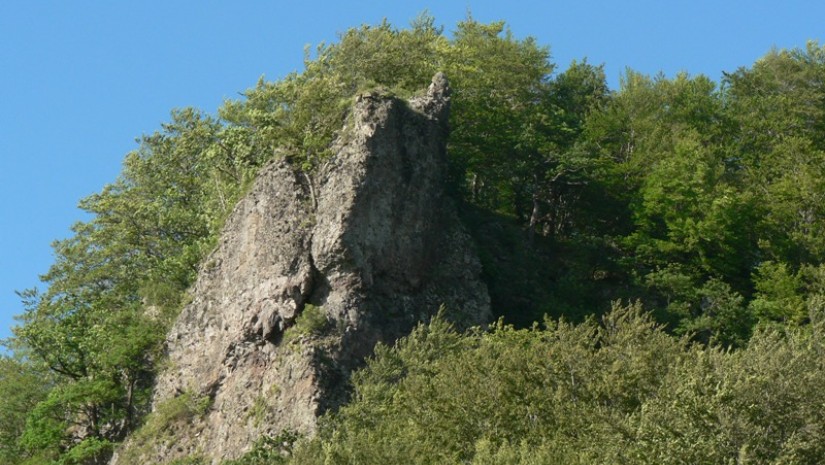-

Photo: Wikipédia -

Photo: Cazare Praid


Rapsonné's Castle
One of the most mysterious medieval ruins in Székely Land is located near Praid, on a steep, forest-covered hilltop. The remnants of the fortress known as Rapsonné's Castle are nestled among andesite rocks – moss-covered walls, sunken stones, and a man-made water reservoir tell the story of the fortress's former role. Although historical records suggest the castle was built in the 13th century and likely provided refuge for locals during the Mongol invasion, today it is the legends associated with it and its enchanting natural surroundings that make this place truly unique.
More information

History and Architectural Features
Rapsonné's Castle was likely a small, inner-towered fortress, with remnants of its walls still visible on the northern side. The castle was probably built as part of medieval border defences for protective purposes, but it was abandoned after a short period of use. As there was no natural spring on the hilltop, a rainwater collection basin carved into the rock was created, which would have been essential for survival. The uniqueness of the ruins lies precisely in this: the traces of the structure, blending almost seamlessly with its surroundings, barely disrupt the natural rhythm of the forest.
Legends of Rapsonné
According to folklore, Rapsonné was a fairy woman or witch who used her supernatural powers to have her castle built atop the hill. Legend has it that instead of masons, a black cat and a rooster carried the building materials for the castle. Another tale suggests that Rapsonné's siblings built several nearby castles – such as Tartód and Budvár – and in the evenings, they would light candles in them simultaneously to stay in contact with one another.
Another famous legend tells of Rapsonné attending mass in Cluj – but not in an ordinary way. She made a pact with the devil to create a magical road over the mountains leading all the way to the treasure city, where she would appear every Sunday in a splendid carriage. According to the legend, the devil demanded the gold of Parajd's mountain and the silver of the valley in return, but Rapsonné outwitted him: she had the road built but never handed over the treasures.
Rapsonné's Rose is a unique flower that – according to locals – only blooms near the castle, and it is said that Rapsonné herself planted it to keep the mountain and her memory alive forever. The flower is small, pinkish in hue, and rarely blooms – those who see it are believed to be blessed with extraordinary luck. Some say the flower only reveals itself to those who approach the ruins quietly and respectfully.
Nature and Sustainable Visits
Rapsonné's Castle is located in a natural setting that exudes a special sense of peace and tranquillity. The trail leading up the pine-covered hillside – the legendary Rapsonné's Path – is accessible on foot and cannot be reached by car. The hike is of moderate difficulty, but the sacred atmosphere of the place and the serenity of nature make every step worthwhile. There are no tourist centres, snack bars, or built infrastructure near the ruins – this is precisely what preserves its charm and untouched character.
Visitors can enjoy a truly nature-immersive experience during the hike, exploring traces of the past at their own pace. To ensure sustainable visits, it is important for everyone to stay on designated paths and leave no trace behind – neither litter nor noise. The wildlife around the ruins is sensitive, and early morning or twilight visits offer particularly rich bird songs, scents, and light.
Accessibility
Rapsonné's Castle can be reached on foot from Parajd. The hike starts near the Reformed Church in Parajd, following a forest trail uphill for approximately 3 km, with a moderately challenging walk. Part of the route follows the legendary Rapsonné's Path, a stone-paved, now overgrown trail that leads up to the rocky ridge of the castle. The round trip takes about 2–2.5 hours, and sturdy hiking shoes are recommended.
The site is not accessible by vehicle; the entire route must be completed on foot to protect the natural environment and the ruins. There are no signposts, but the route is easy to follow with the help of locals or guides. Peace and a close-to-nature experience are guaranteed – the visit is not just a hike but also a kind of pilgrimage into the world of the past and imagination.
Target group
-
Class trips
-
Families with older children
-
Multigenerational programs
-
Friends
-
Couples




